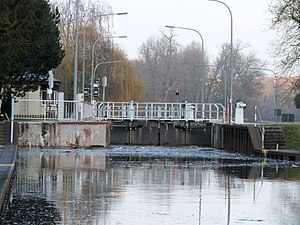Böllberg lock
| Böllberg lock | ||
|---|---|---|
|
At the bottom of the lock with mortise gate |
||
| location | ||
|
|
||
| Coordinates | 51 ° 27 '49 " N , 11 ° 56' 48" E | |
| Country: |
|
|
| Place: | Halle (Saale) | |
| Waters: | Saale | |
| Water kilometers : | km 95.85 | |
| Data | ||
| Owner: | Federal waterways and shipping administration | |
| Responsible WSA : | Magdeburg | |
| Construction time: | 1817-1820 | |
| Start of operation: | 1820 | |
| Modification: | 1872-1874 | |
| lock | ||
| Type: | Chamber lock in block construction | |
| Category: | Class I. | |
| Usable length: | 47.29 m | |
| Usable width: | Gate width 5.60 m, chamber width 5.60 m |
|
| Average height of fall : |
1.35 m | |
| Upper gate: | Miter gate | |
| Lower gate: | Miter gate | |
| Others | ||
| Was standing: | Tel. +49 345 441056 | |
The Böllberg lock is a lock at kilometer 95.85 of the Saale federal waterway . It is located in the urban area of the city of Halle (Saale) in Saxony-Anhalt . The lock was named after the former fishing village of Böllberg an der Saale, which is now in the urban area. Registration for the smuggling takes place by phone. It is located in the area of responsibility of outer district 5 (ABZ 5) in Merseburg of the Magdeburg Waterways and Shipping Office . Between Trotha and the Leuna -Kröllwitz pipe bridge (Saale-Km 124.40) the Saale has waterway class I and is mainly used by passenger and sport shipping. There are five locks in the urban area of Halle. Saale down, these are the lock Planena , the lock Boellberg, the city gate , the lock Gimritz and lock Halle-Trotha . The systems compensate the ships for a difference in height of around nine meters over a river length of 15 kilometers.
history
The use of the Saale for goods or passenger transport has been documented since 981. It is reported in chronicles of the Saale shipping that the water of the Saale river was dammed as early as the second half of the 14th century . The accumulated amount of water was used to operate mills and rafts. On October 21, 1530, Emperor Karl V granted the archbishopric of Magdeburg the privilege of free navigation on the Saale and permission to expand the river. The first wooden locks were used by the boatmen to handle freight traffic. Prince Wolfgang von Anhalt , regent of Bernburg, signed a contract in 1559 at the insistence of Archbishop Sigismund to expand and secure shipping on the Saale. Not until almost 100 years later, from 1790 onwards, shipping on the Saale was further expanded. The Elector of Saxony, Friedrich August III. , ordered that the upper hall and the Unstrut be made navigable. After 1816, the Halle city master builder Johann Justus Peter Schulze was entrusted with the construction of the Böllberg and Planena locks .
The still available and usable lock should by the bypass channel hall with the lock hall be bypassed. The construction documents were fully prepared. The three locks, the Gimritz lock , the Halle city lock and the Böllberg lock were to be bypassed and the waterway made usable for the 1000-tonne ship. As for the Saale locks between Calbe and Wettin , a useful length of just over 100 meters and a width of 20 meters was planned. The Halle bypass canal and the Halle lock were neither built nor completed due to the war.
description
Since the Saale was very branched at that time and formed many islands, it was possible to build weirs and locks in many places. Larger interventions in the river landscape to build mills were not necessary and the developing Saale shipping and rafting were not unduly hindered. During the reign of Elector Friedrich III. In the 1690s, the existing wooden locks were converted into massive locks with stone walls, almost always made of local sandstone. In 1817–1822, the Saale was made navigable from Halle upwards and further the Unstrut to Artern and a lock was therefore built near Böllberg . Today's Böllberg lock is a reinforced concrete lock with mortise gates made of steel. The lock is emptied and filled using sliding gates on the side.
literature
- M. Eckoldt (Ed.), Rivers and Canals, The History of German Waterways, DSV-Verlag 1998, ISBN 978-3884122433
- Pestalozzi Association of the Province of Saxony . The province of Saxony in words and pictures. I. Volume. Published by Julius Klinkhardt, 1902, pp. 95 ff.
- Hans-J. Uhlemann: Berlin and the Märkische waterways . transpress Verlag, Berlin, various years, ISBN 3-344-00115-9
- Herbert Sterz: Havel shipping under sail . Verlag MEDIA @ VICE, Pritzwalk 2005, ISBN 3-00-016065-5
Web links
- Wasserstraßen- und Schifffahrtsamt Magdeburg, outskirts 5 , accessed on January 28, 2018
- Website of the Saale-Elster-Kanal Förderverein eV , accessed on January 21, 2018
- Aerial photograph of the Böllberg lock , accessed on January 21, 2018
Individual evidence
- ↑ Schleuse Böllberg on the WSA Abz 5 page , accessed on January 21, 2018
- ↑ Halle's forgotten master builder - Johann Justus Peter Schulze. In: immohal.de. March 2018, accessed March 12, 2019 .
- ↑ Reading sample WSA-ABZ Merseburg . Reading sample as a PDF file

